2012 BMW 640I COUPE tire size
[x] Cancel search: tire sizePage 92 of 303
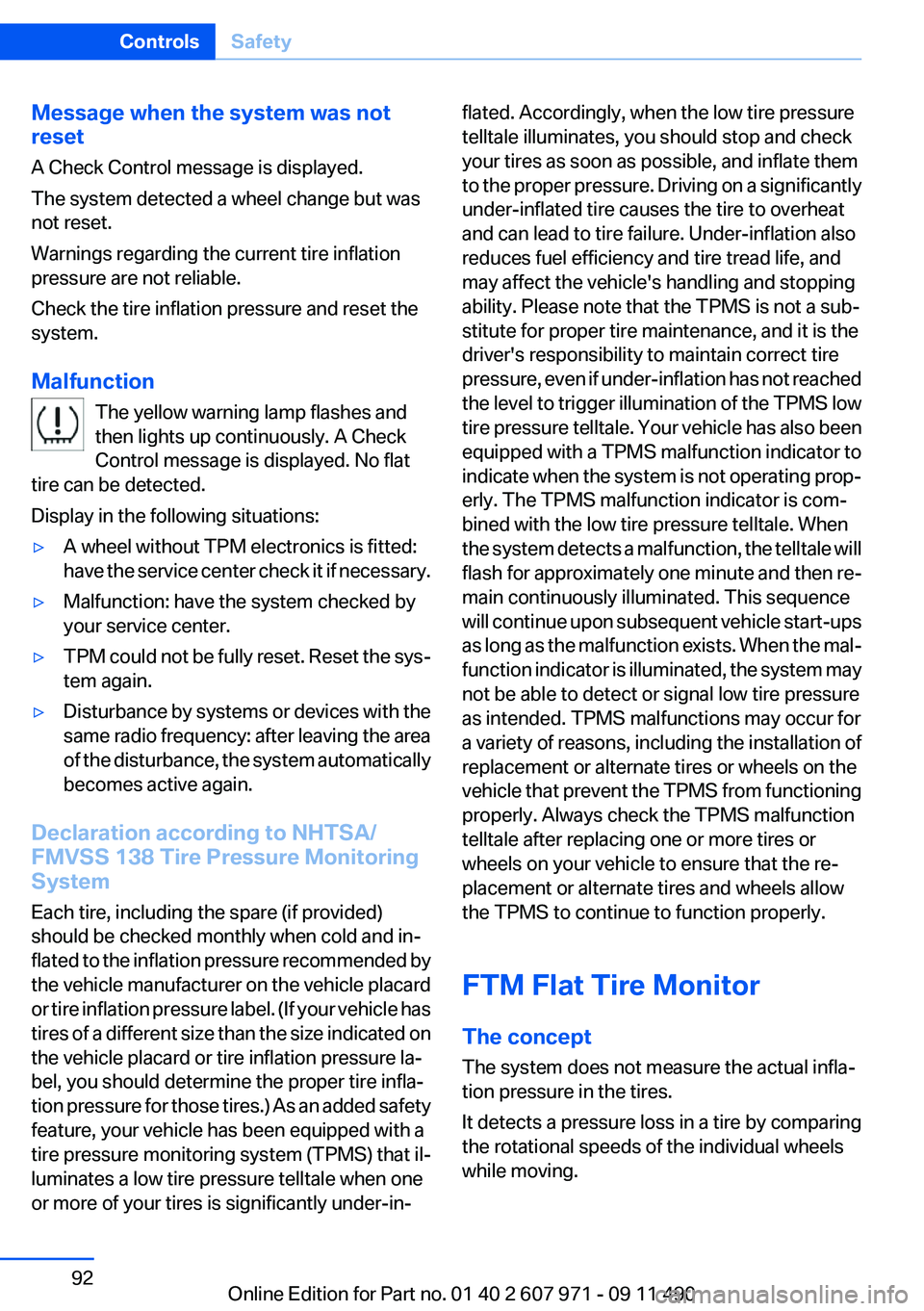
Message when the system was not
reset
A Check Control message is displayed.
The system detected a wheel change but was
not reset.
Warnings regarding the current tire inflation
pressure are not reliable.
Check the tire inflation pressure and reset the
system.
Malfunction The yellow warning lamp flashes and
then lights up continuously. A Check
Control message is displayed. No flat
tire can be detected.
Display in the following situations:▷A wheel without TPM electronics is fitted:
have the service center check it if necessary.▷Malfunction: have the system checked by
your service center.▷TPM could not be fully reset. Reset the sys‐
tem again.▷Disturbance by systems or devices with the
same radio frequency: after leaving the area
of the disturbance, the system automatically
becomes active again.
Declaration according to NHTSA/
FMVSS 138 Tire Pressure Monitoring
System
Each tire, including the spare (if provided)
should be checked monthly when cold and in‐
flated to the inflation pressure recommended by
the vehicle manufacturer on the vehicle placard
or tire inflation pressure label. (If your vehicle has
tires of a different size than the size indicated on
the vehicle placard or tire inflation pressure la‐
bel, you should determine the proper tire infla‐
tion pressure for those tires.) As an added safety
feature, your vehicle has been equipped with a
tire pressure monitoring system (TPMS) that il‐
luminates a low tire pressure telltale when one
or more of your tires is significantly under-in‐
flated. Accordingly, when the low tire pressure
telltale illuminates, you should stop and check
your tires as soon as possible, and inflate them
to the proper pressure. Driving on a significantly
under-inflated tire causes the tire to overheat
and can lead to tire failure. Under-inflation also
reduces fuel efficiency and tire tread life, and
may affect the vehicle's handling and stopping
ability. Please note that the TPMS is not a sub‐
stitute for proper tire maintenance, and it is the
driver's responsibility to maintain correct tire
pressure, even if under-inflation has not reached
the level to trigger illumination of the TPMS low
tire pressure telltale. Your vehicle has also been
equipped with a TPMS malfunction indicator to
indicate when the system is not operating prop‐
erly. The TPMS malfunction indicator is com‐
bined with the low tire pressure telltale. When
the system detects a malfunction, the telltale will
flash for approximately one minute and then re‐
main continuously illuminated. This sequence
will continue upon subsequent vehicle start-ups
as long as the malfunction exists. When the mal‐
function indicator is illuminated, the system may
not be able to detect or signal low tire pressure
as intended. TPMS malfunctions may occur for
a variety of reasons, including the installation of
replacement or alternate tires or wheels on the
vehicle that prevent the TPMS from functioning
properly. Always check the TPMS malfunction
telltale after replacing one or more tires or
wheels on your vehicle to ensure that the re‐
placement or alternate tires and wheels allow
the TPMS to continue to function properly.
FTM Flat Tire Monitor
The concept
The system does not measure the actual infla‐
tion pressure in the tires.
It detects a pressure loss in a tire by comparing
the rotational speeds of the individual wheels
while moving.Seite 92ControlsSafety92
Online Edition for Part no. 01 40 2 607 971 - 09 11 490
Page 128 of 303
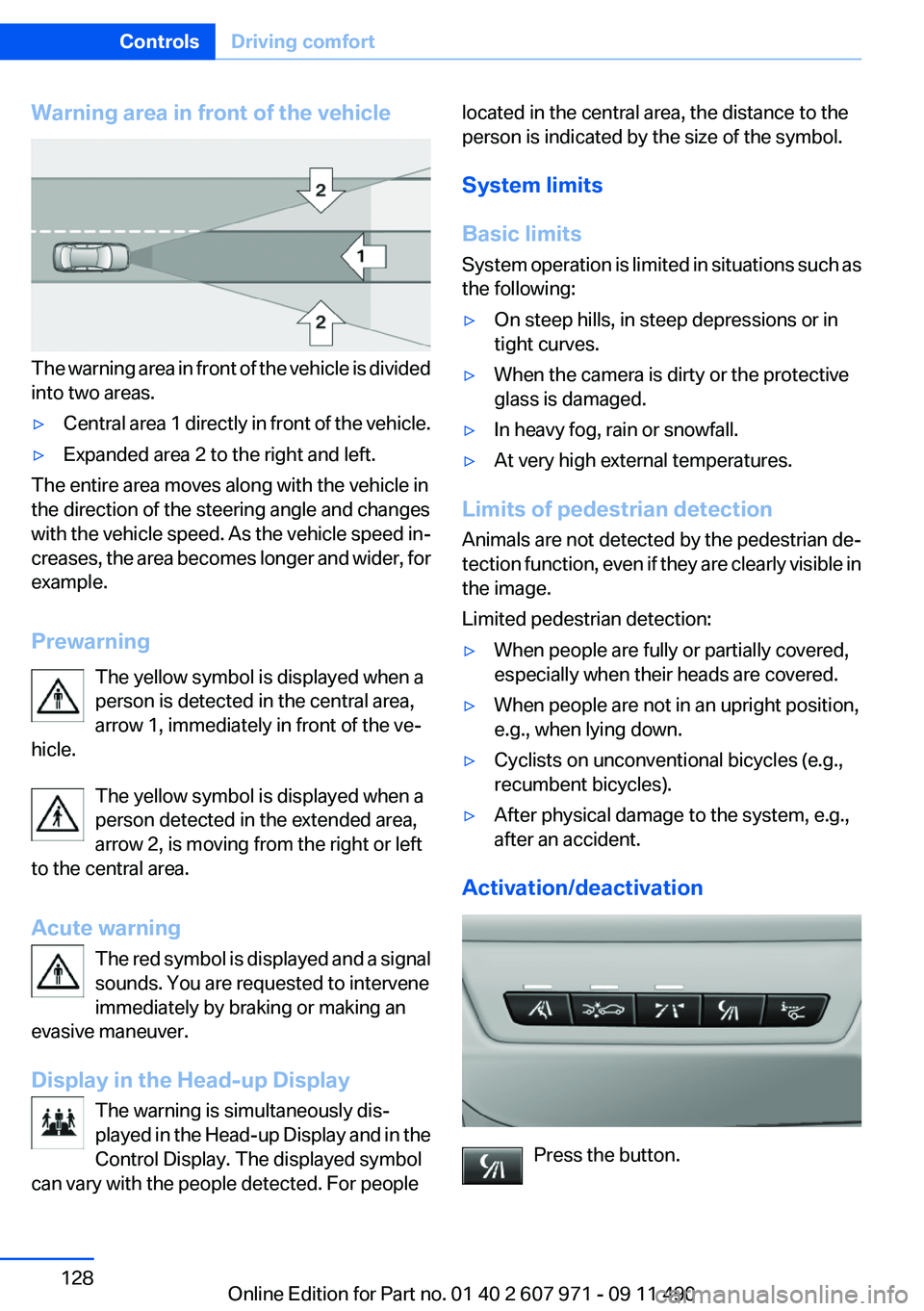
Warning area in front of the vehicle
The warning area in front of the vehicle is divided
into two areas.
▷Central area 1 directly in front of the vehicle.▷Expanded area 2 to the right and left.
The entire area moves along with the vehicle in
the direction of the steering angle and changes
with the vehicle speed. As the vehicle speed in‐
creases, the area becomes longer and wider, for
example.
Prewarning The yellow symbol is displayed when a
person is detected in the central area,
arrow 1, immediately in front of the ve‐
hicle.
The yellow symbol is displayed when a
person detected in the extended area,
arrow 2, is moving from the right or left
to the central area.
Acute warning The red symbol is displayed and a signal
sounds. You are requested to intervene
immediately by braking or making an
evasive maneuver.
Display in the Head-up Display The warning is simultaneously dis‐
played in the Head-up Display and in the
Control Display. The displayed symbol
can vary with the people detected. For people
located in the central area, the distance to the
person is indicated by the size of the symbol.
System limits
Basic limits
System operation is limited in situations such as
the following:▷On steep hills, in steep depressions or in
tight curves.▷When the camera is dirty or the protective
glass is damaged.▷In heavy fog, rain or snowfall.▷At very high external temperatures.
Limits of pedestrian detection
Animals are not detected by the pedestrian de‐
tection function, even if they are clearly visible in
the image.
Limited pedestrian detection:
▷When people are fully or partially covered,
especially when their heads are covered.▷When people are not in an upright position,
e.g., when lying down.▷Cyclists on unconventional bicycles (e.g.,
recumbent bicycles).▷After physical damage to the system, e.g.,
after an accident.
Activation/deactivation
Press the button.
Seite 128ControlsDriving comfort128
Online Edition for Part no. 01 40 2 607 971 - 09 11 490
Page 245 of 303
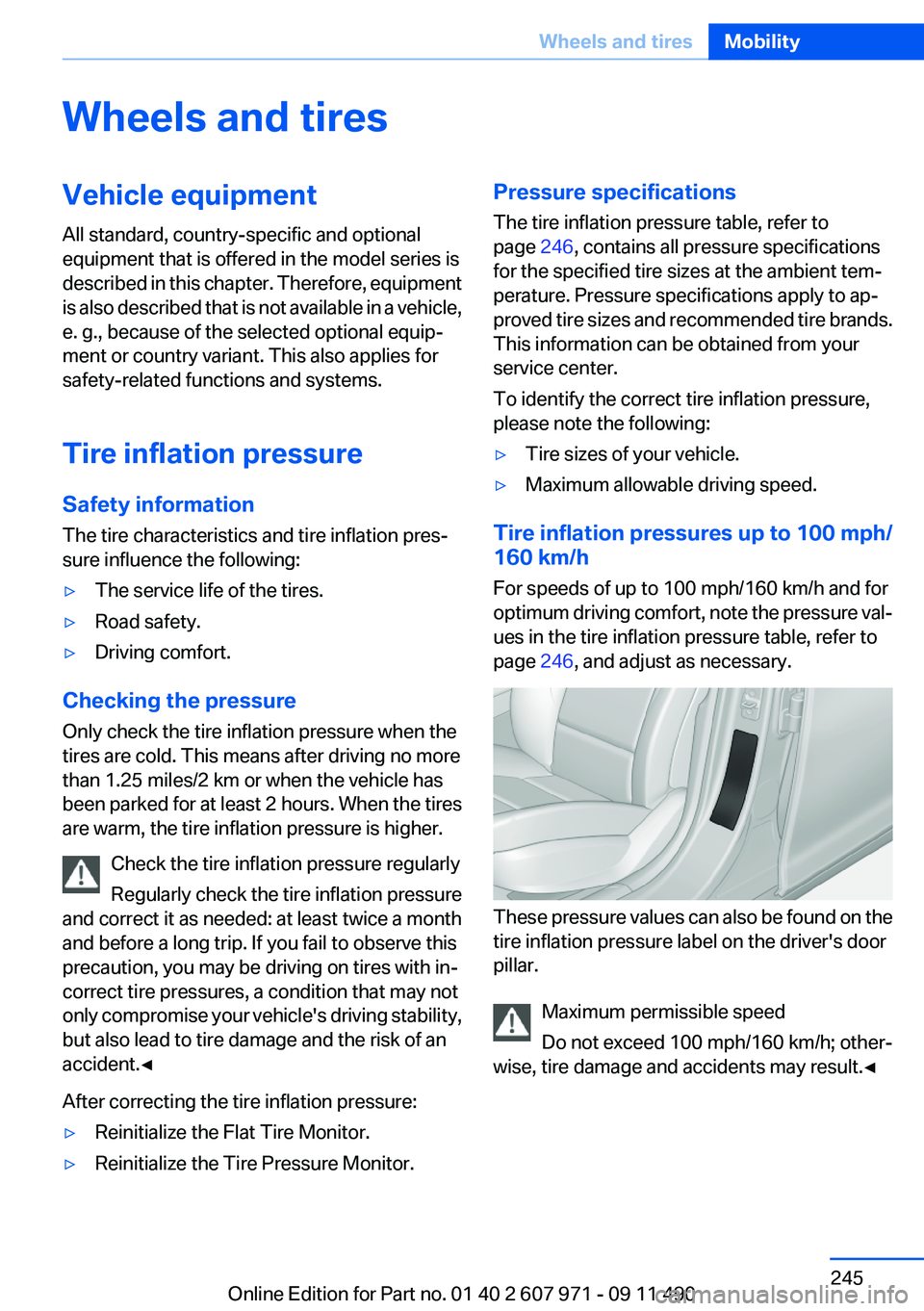
Wheels and tiresVehicle equipment
All standard, country-specific and optional
equipment that is offered in the model series is
described in this chapter. Therefore, equipment
is also described that is not available in a vehicle,
e. g., because of the selected optional equip‐
ment or country variant. This also applies for
safety-related functions and systems.
Tire inflation pressure
Safety information
The tire characteristics and tire inflation pres‐
sure influence the following:▷The service life of the tires.▷Road safety.▷Driving comfort.
Checking the pressure
Only check the tire inflation pressure when the
tires are cold. This means after driving no more
than 1.25 miles/2 km or when the vehicle has
been parked for at least 2 hours. When the tires
are warm, the tire inflation pressure is higher.
Check the tire inflation pressure regularly
Regularly check the tire inflation pressure
and correct it as needed: at least twice a month
and before a long trip. If you fail to observe this
precaution, you may be driving on tires with in‐
correct tire pressures, a condition that may not
only compromise your vehicle's driving stability,
but also lead to tire damage and the risk of an
accident.◀
After correcting the tire inflation pressure:
▷Reinitialize the Flat Tire Monitor.▷Reinitialize the Tire Pressure Monitor.Pressure specifications
The tire inflation pressure table, refer to
page 246, contains all pressure specifications
for the specified tire sizes at the ambient tem‐
perature. Pressure specifications apply to ap‐
proved tire sizes and recommended tire brands.
This information can be obtained from your
service center.
To identify the correct tire inflation pressure,
please note the following:▷Tire sizes of your vehicle.▷Maximum allowable driving speed.
Tire inflation pressures up to 100 mph/
160 km/h
For speeds of up to 100 mph/160 km/h and for
optimum driving comfort, note the pressure val‐
ues in the tire inflation pressure table, refer to
page 246, and adjust as necessary.
These pressure values can also be found on the
tire inflation pressure label on the driver's door
pillar.
Maximum permissible speed
Do not exceed 100 mph/160 km/h; other‐
wise, tire damage and accidents may result.◀
Seite 245Wheels and tiresMobility245
Online Edition for Part no. 01 40 2 607 971 - 09 11 490
Page 246 of 303
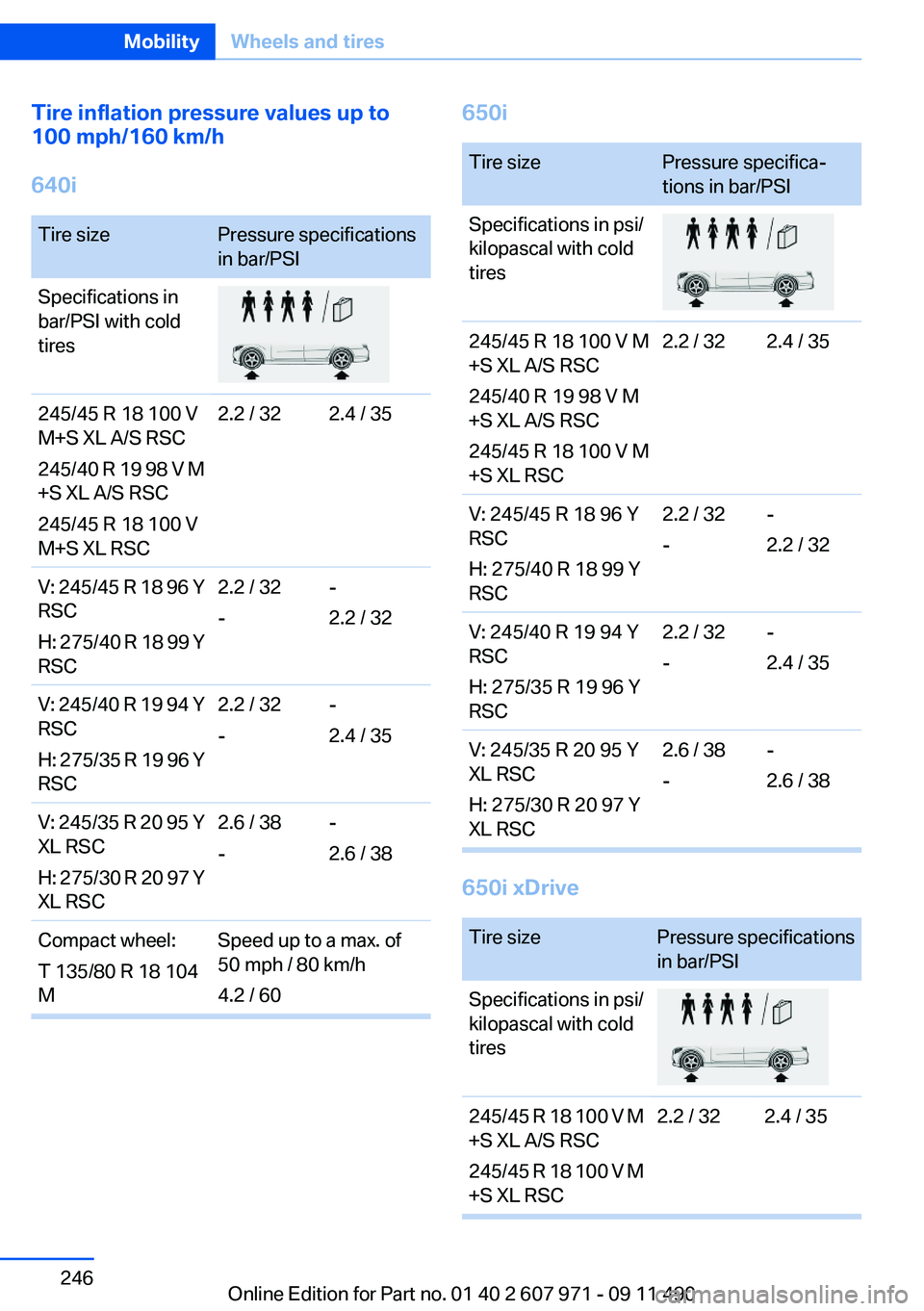
Tire inflation pressure values up to
100 mph/160 km/h
640iTire sizePressure specifications
in bar/PSISpecifications in
bar/PSI with cold
tires245/45 R 18 100 V
M+S XL A/S RSC
245/40 R 19 98 V M
+S XL A/S RSC
245/45 R 18 100 V
M+S XL RSC2.2 / 322.4 / 35V: 245/45 R 18 96 Y
RSC
H: 275/40 R 18 99 Y
RSC2.2 / 32
--
2.2 / 32V: 245/40 R 19 94 Y
RSC
H: 275/35 R 19 96 Y
RSC2.2 / 32
--
2.4 / 35V: 245/35 R 20 95 Y
XL RSC
H: 275/30 R 20 97 Y
XL RSC2.6 / 38
--
2.6 / 38Compact wheel:
T 135/80 R 18 104
MSpeed up to a max. of
50 mph / 80 km/h
4.2 / 60650iTire sizePressure specifica‐
tions in bar/PSISpecifications in psi/
kilopascal with cold
tires245/45 R 18 100 V M
+S XL A/S RSC
245/40 R 19 98 V M
+S XL A/S RSC
245/45 R 18 100 V M
+S XL RSC2.2 / 322.4 / 35V: 245/45 R 18 96 Y
RSC
H: 275/40 R 18 99 Y
RSC2.2 / 32
--
2.2 / 32V: 245/40 R 19 94 Y
RSC
H: 275/35 R 19 96 Y
RSC2.2 / 32
--
2.4 / 35V: 245/35 R 20 95 Y
XL RSC
H: 275/30 R 20 97 Y
XL RSC2.6 / 38
--
2.6 / 38
650i xDrive
Tire sizePressure specifications
in bar/PSISpecifications in psi/
kilopascal with cold
tires245/45 R 18 100 V M
+S XL A/S RSC
245/45 R 18 100 V M
+S XL RSC2.2 / 322.4 / 35Seite 246MobilityWheels and tires246
Online Edition for Part no. 01 40 2 607 971 - 09 11 490
Page 247 of 303
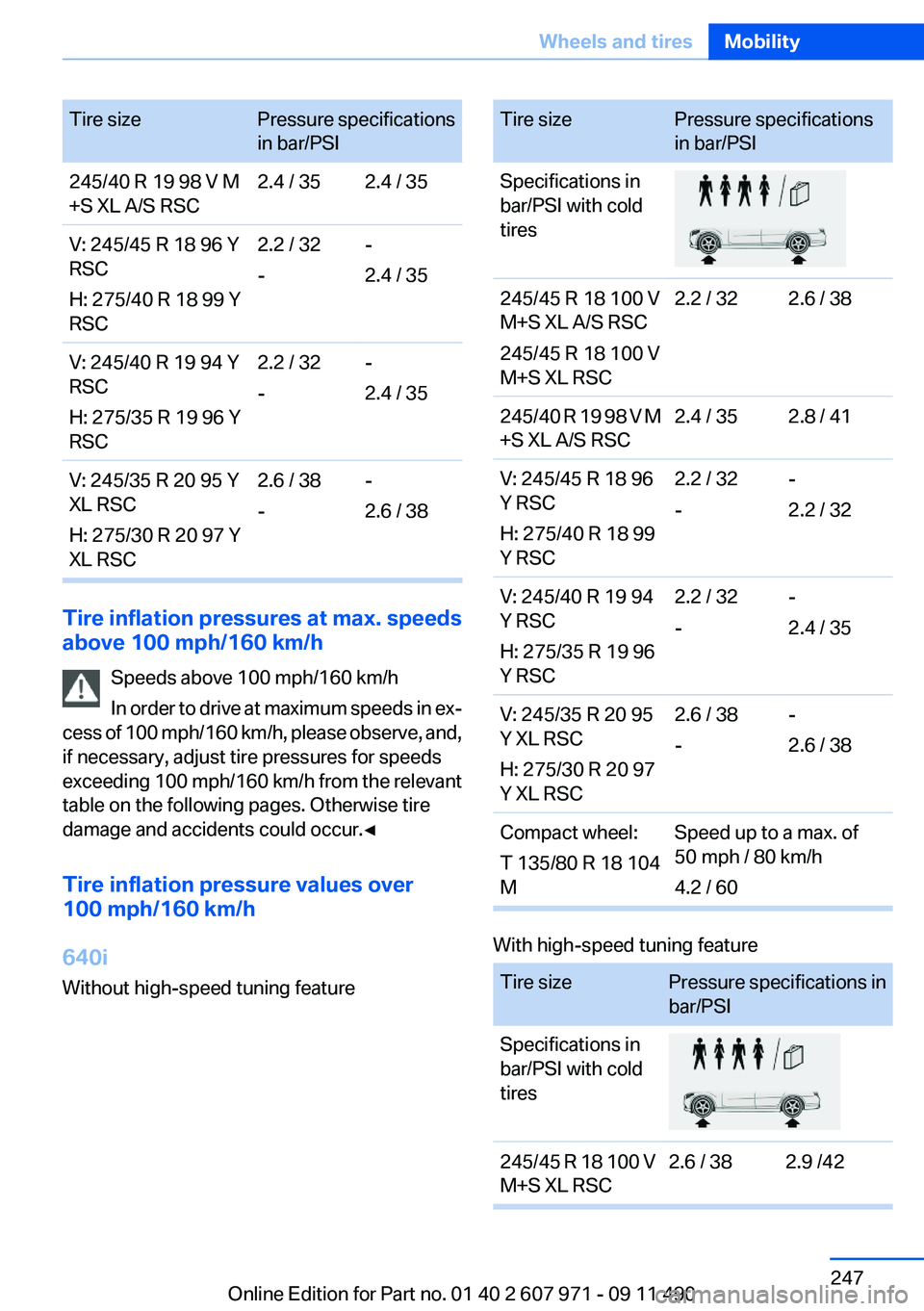
Tire sizePressure specifications
in bar/PSI245/40 R 19 98 V M
+S XL A/S RSC2.4 / 352.4 / 35V: 245/45 R 18 96 Y
RSC
H: 275/40 R 18 99 Y
RSC2.2 / 32
--
2.4 / 35V: 245/40 R 19 94 Y
RSC
H: 275/35 R 19 96 Y
RSC2.2 / 32
--
2.4 / 35V: 245/35 R 20 95 Y
XL RSC
H: 275/30 R 20 97 Y
XL RSC2.6 / 38
--
2.6 / 38
Tire inflation pressures at max. speeds
above 100 mph/160 km/h
Speeds above 100 mph/160 km/h
In order to drive at maximum speeds in ex‐
cess of 100 mph/160 km/h, please observe, and,
if necessary, adjust tire pressures for speeds
exceeding 100 mph/160 km/h from the relevant
table on the following pages. Otherwise tire
damage and accidents could occur.◀
Tire inflation pressure values over
100 mph/160 km/h
640i
Without high-speed tuning feature
Tire sizePressure specifications
in bar/PSISpecifications in
bar/PSI with cold
tires245/45 R 18 100 V
M+S XL A/S RSC
245/45 R 18 100 V
M+S XL RSC2.2 / 322.6 / 38245/40 R 19 98 V M
+S XL A/S RSC2.4 / 352.8 / 41V: 245/45 R 18 96
Y RSC
H: 275/40 R 18 99
Y RSC2.2 / 32
--
2.2 / 32V: 245/40 R 19 94
Y RSC
H: 275/35 R 19 96
Y RSC2.2 / 32
--
2.4 / 35V: 245/35 R 20 95
Y XL RSC
H: 275/30 R 20 97
Y XL RSC2.6 / 38
--
2.6 / 38Compact wheel:
T 135/80 R 18 104
MSpeed up to a max. of
50 mph / 80 km/h
4.2 / 60
With high-speed tuning feature
Tire sizePressure specifications in
bar/PSISpecifications in
bar/PSI with cold
tires245/45 R 18 100 V
M+S XL RSC2.6 / 382.9 /42Seite 247Wheels and tiresMobility247
Online Edition for Part no. 01 40 2 607 971 - 09 11 490
Page 248 of 303
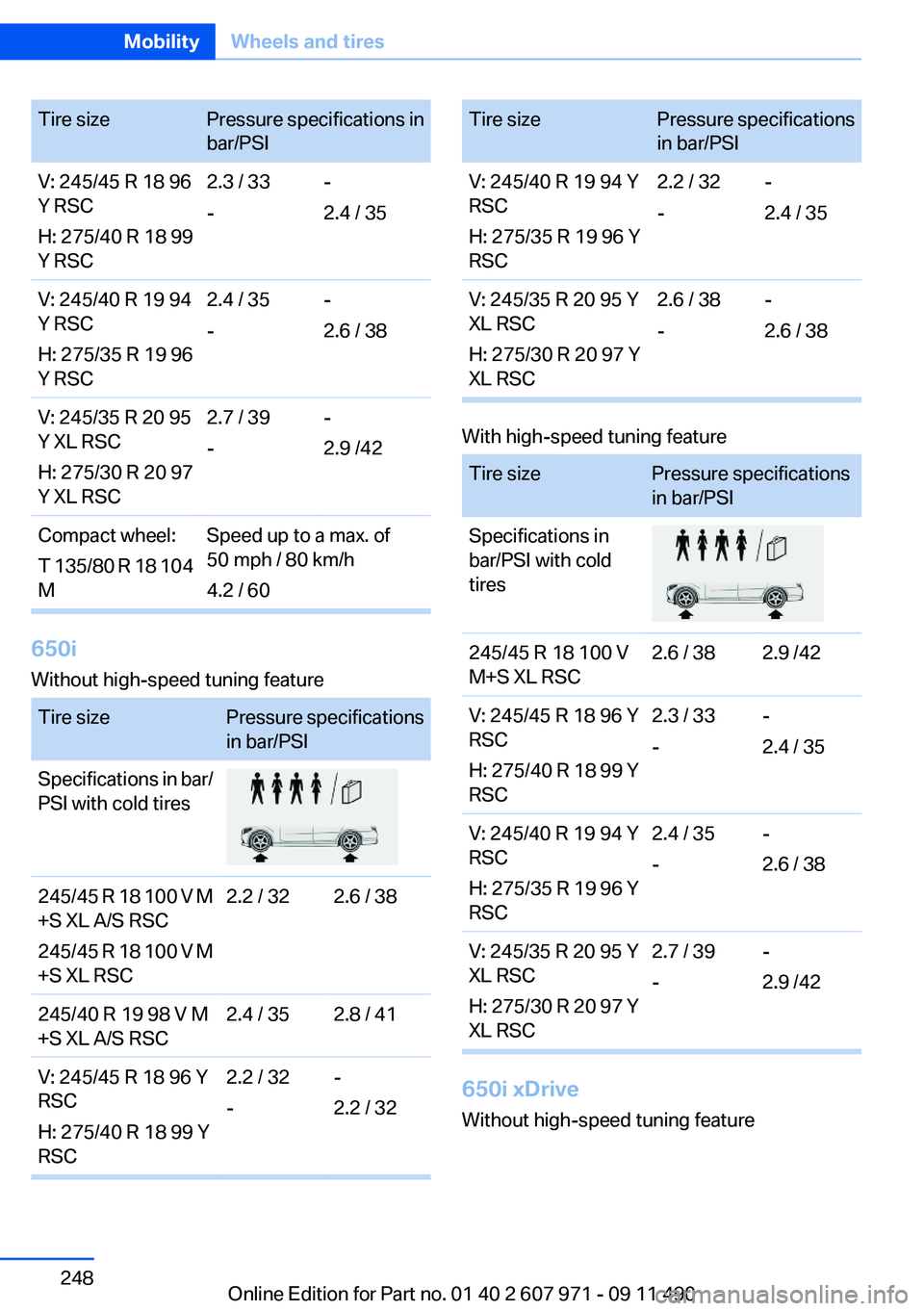
Tire sizePressure specifications in
bar/PSIV: 245/45 R 18 96
Y RSC
H: 275/40 R 18 99
Y RSC2.3 / 33
--
2.4 / 35V: 245/40 R 19 94
Y RSC
H: 275/35 R 19 96
Y RSC2.4 / 35
--
2.6 / 38V: 245/35 R 20 95
Y XL RSC
H: 275/30 R 20 97
Y XL RSC2.7 / 39
--
2.9 /42Compact wheel:
T 135/80 R 18 104
MSpeed up to a max. of
50 mph / 80 km/h
4.2 / 60
650i
Without high-speed tuning feature
Tire sizePressure specifications
in bar/PSISpecifications in bar/
PSI with cold tires245/45 R 18 100 V M
+S XL A/S RSC
245/45 R 18 100 V M
+S XL RSC2.2 / 322.6 / 38245/40 R 19 98 V M
+S XL A/S RSC2.4 / 352.8 / 41V: 245/45 R 18 96 Y
RSC
H: 275/40 R 18 99 Y
RSC2.2 / 32
--
2.2 / 32Tire sizePressure specifications
in bar/PSIV: 245/40 R 19 94 Y
RSC
H: 275/35 R 19 96 Y
RSC2.2 / 32
--
2.4 / 35V: 245/35 R 20 95 Y
XL RSC
H: 275/30 R 20 97 Y
XL RSC2.6 / 38
--
2.6 / 38
With high-speed tuning feature
Tire sizePressure specifications
in bar/PSISpecifications in
bar/PSI with cold
tires245/45 R 18 100 V
M+S XL RSC2.6 / 382.9 /42V: 245/45 R 18 96 Y
RSC
H: 275/40 R 18 99 Y
RSC2.3 / 33
--
2.4 / 35V: 245/40 R 19 94 Y
RSC
H: 275/35 R 19 96 Y
RSC2.4 / 35
--
2.6 / 38V: 245/35 R 20 95 Y
XL RSC
H: 275/30 R 20 97 Y
XL RSC2.7 / 39
--
2.9 /42
650i xDrive
Without high-speed tuning feature
Seite 248MobilityWheels and tires248
Online Edition for Part no. 01 40 2 607 971 - 09 11 490
Page 249 of 303
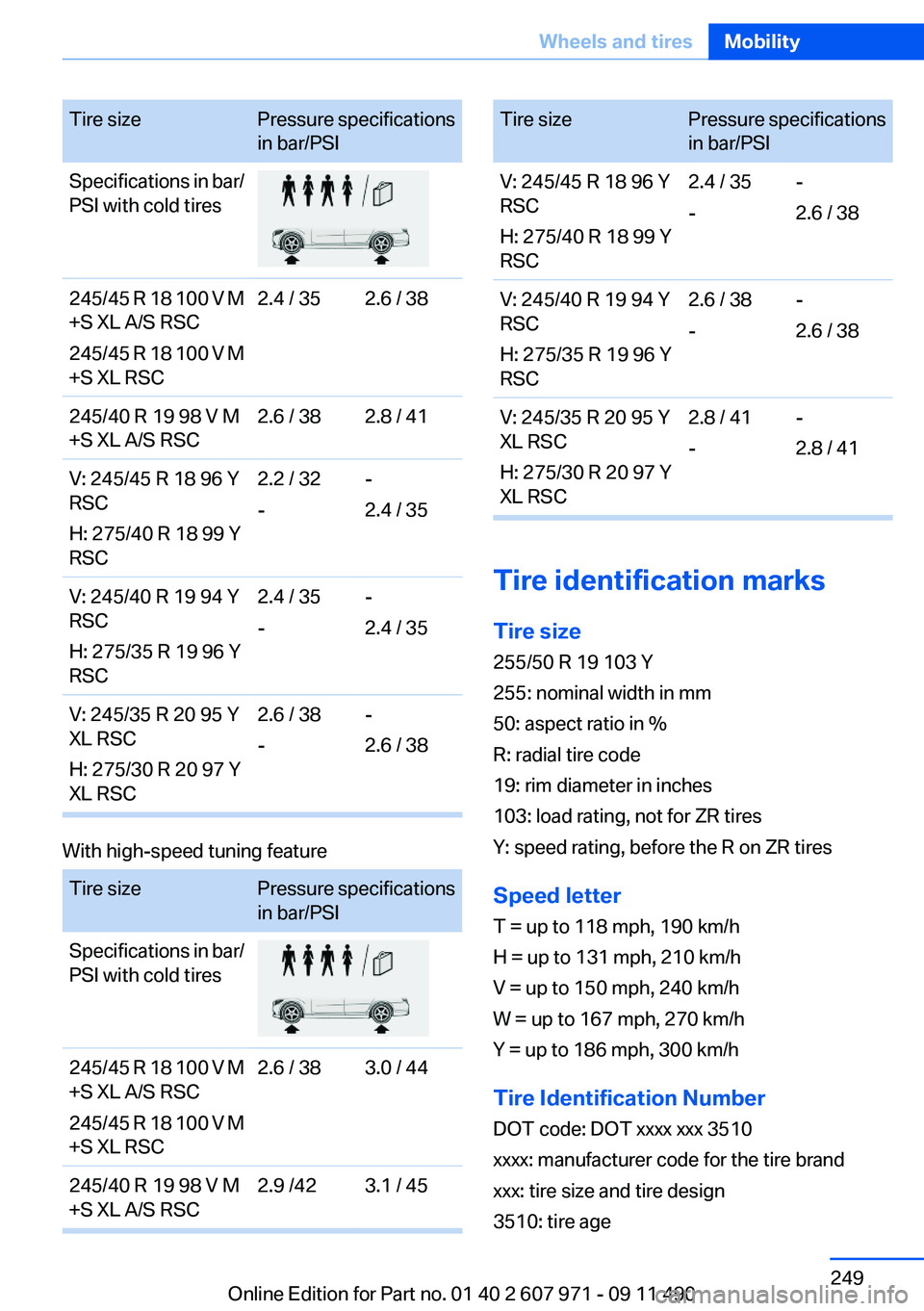
Tire sizePressure specifications
in bar/PSISpecifications in bar/
PSI with cold tires245/45 R 18 100 V M
+S XL A/S RSC
245/45 R 18 100 V M
+S XL RSC2.4 / 352.6 / 38245/40 R 19 98 V M
+S XL A/S RSC2.6 / 382.8 / 41V: 245/45 R 18 96 Y
RSC
H: 275/40 R 18 99 Y
RSC2.2 / 32
--
2.4 / 35V: 245/40 R 19 94 Y
RSC
H: 275/35 R 19 96 Y
RSC2.4 / 35
--
2.4 / 35V: 245/35 R 20 95 Y
XL RSC
H: 275/30 R 20 97 Y
XL RSC2.6 / 38
--
2.6 / 38
With high-speed tuning feature
Tire sizePressure specifications
in bar/PSISpecifications in bar/
PSI with cold tires245/45 R 18 100 V M
+S XL A/S RSC
245/45 R 18 100 V M
+S XL RSC2.6 / 383.0 / 44245/40 R 19 98 V M
+S XL A/S RSC2.9 /423.1 / 45Tire sizePressure specifications
in bar/PSIV: 245/45 R 18 96 Y
RSC
H: 275/40 R 18 99 Y
RSC2.4 / 35
--
2.6 / 38V: 245/40 R 19 94 Y
RSC
H: 275/35 R 19 96 Y
RSC2.6 / 38
--
2.6 / 38V: 245/35 R 20 95 Y
XL RSC
H: 275/30 R 20 97 Y
XL RSC2.8 / 41
--
2.8 / 41
Tire identification marks
Tire size
255/50 R 19 103 Y
255: nominal width in mm
50: aspect ratio in %
R: radial tire code
19: rim diameter in inches
103: load rating, not for ZR tires
Y: speed rating, before the R on ZR tires
Speed letter
T = up to 118 mph, 190 km/h
H = up to 131 mph, 210 km/h
V = up to 150 mph, 240 km/h
W = up to 167 mph, 270 km/h
Y = up to 186 mph, 300 km/h
Tire Identification Number
DOT code: DOT xxxx xxx 3510
xxxx: manufacturer code for the tire brand
xxx: tire size and tire design
3510: tire age
Seite 249Wheels and tiresMobility249
Online Edition for Part no. 01 40 2 607 971 - 09 11 490
Page 252 of 303
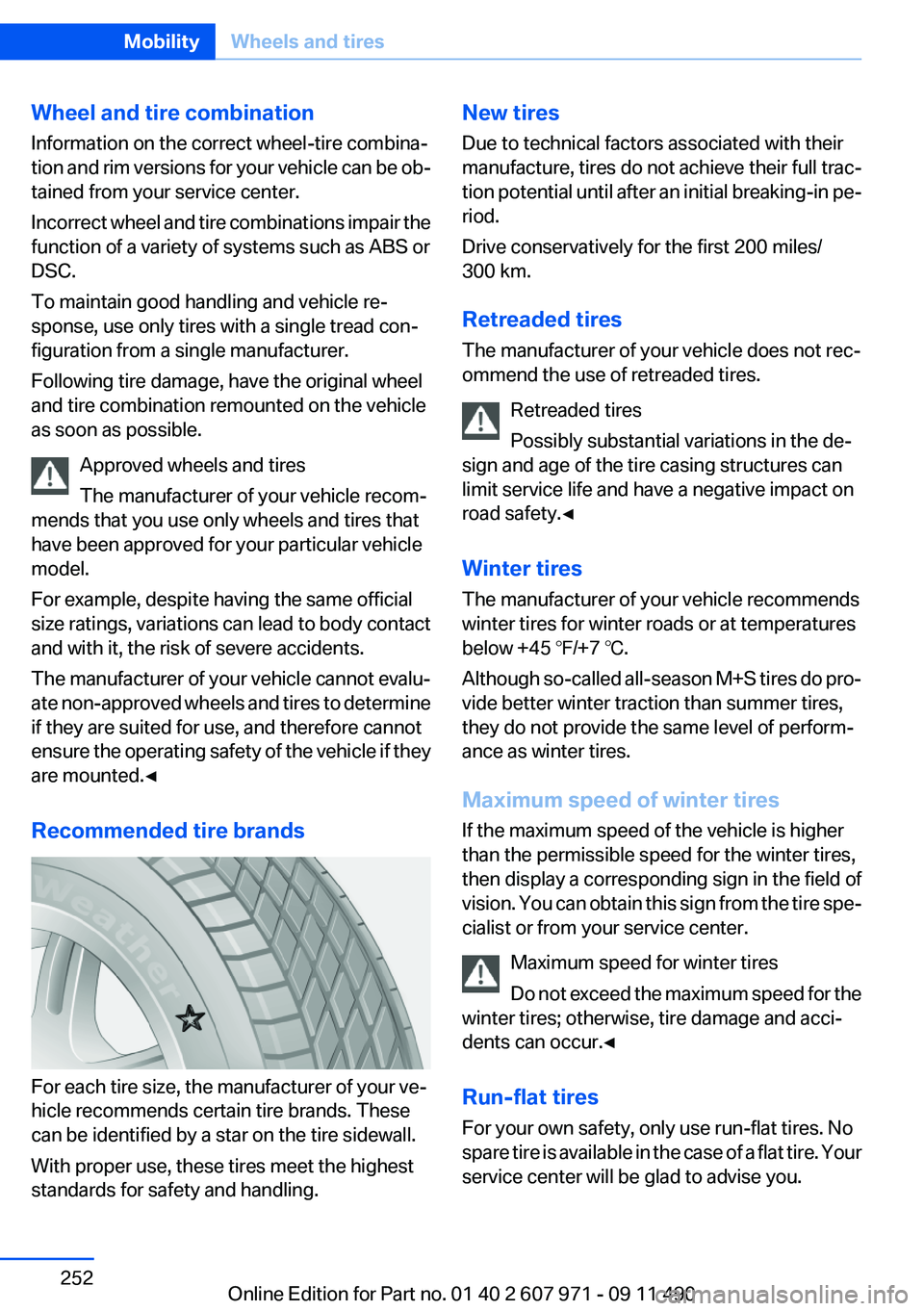
Wheel and tire combination
Information on the correct wheel-tire combina‐
tion and rim versions for your vehicle can be ob‐
tained from your service center.
Incorrect wheel and tire combinations impair the
function of a variety of systems such as ABS or
DSC.
To maintain good handling and vehicle re‐
sponse, use only tires with a single tread con‐
figuration from a single manufacturer.
Following tire damage, have the original wheel
and tire combination remounted on the vehicle
as soon as possible.
Approved wheels and tires
The manufacturer of your vehicle recom‐
mends that you use only wheels and tires that
have been approved for your particular vehicle
model.
For example, despite having the same official
size ratings, variations can lead to body contact
and with it, the risk of severe accidents.
The manufacturer of your vehicle cannot evalu‐
ate non-approved wheels and tires to determine
if they are suited for use, and therefore cannot
ensure the operating safety of the vehicle if they
are mounted.◀
Recommended tire brands
For each tire size, the manufacturer of your ve‐
hicle recommends certain tire brands. These
can be identified by a star on the tire sidewall.
With proper use, these tires meet the highest
standards for safety and handling.
New tires
Due to technical factors associated with their
manufacture, tires do not achieve their full trac‐
tion potential until after an initial breaking-in pe‐
riod.
Drive conservatively for the first 200 miles/
300 km.
Retreaded tires
The manufacturer of your vehicle does not rec‐
ommend the use of retreaded tires.
Retreaded tires
Possibly substantial variations in the de‐
sign and age of the tire casing structures can
limit service life and have a negative impact on
road safety.◀
Winter tires
The manufacturer of your vehicle recommends
winter tires for winter roads or at temperatures
below +45 ℉/+7 ℃.
Although so-called all-season M+S tires do pro‐
vide better winter traction than summer tires,
they do not provide the same level of perform‐
ance as winter tires.
Maximum speed of winter tires
If the maximum speed of the vehicle is higher
than the permissible speed for the winter tires,
then display a corresponding sign in the field of
vision. You can obtain this sign from the tire spe‐
cialist or from your service center.
Maximum speed for winter tires
Do not exceed the maximum speed for the
winter tires; otherwise, tire damage and acci‐
dents can occur.◀
Run-flat tires
For your own safety, only use run-flat tires. No
spare tire is available in the case of a flat tire. Your
service center will be glad to advise you.Seite 252MobilityWheels and tires252
Online Edition for Part no. 01 40 2 607 971 - 09 11 490